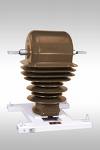How to extend the measurement range of devices in AC circuits
Instrument current transformers
To extend the AC measurement limits for ammeters and other devices with current coils (meters, phasors, wattmeters, etc.), use instrument current transformers… They consist of a magnetic circuit, one primary and one or more secondary windings.
The primary winding of the current transformer L1 — L2 is connected in series to the circuit of the measured current, an ammeter or a current winding of another device is connected to the secondary winding I1 — I2.
The secondary winding of the current transformer is usually made for a current of 5 A. There are also transformers with a rated secondary current of 1 A and 10 A. Primary rated currents can be from 5 to 15,000 A.
 When the primary winding L1 — L2 is switched on, the secondary winding I1 — I2 must be closed to the current winding of the device or short-circuited. Otherwise big electromotive force (1000 — 1500 V), dangerous to human life and secondary insulation.
When the primary winding L1 — L2 is switched on, the secondary winding I1 — I2 must be closed to the current winding of the device or short-circuited. Otherwise big electromotive force (1000 — 1500 V), dangerous to human life and secondary insulation.
For current transformers, one end of the secondary winding and the case are grounded.
The measuring current transformer is selected according to the following data:
a) according to the rated primary current,
b) according to the nominal transformation ratio. It is indicated in the passport of the transformer in the form of a fraction: in the numerator — the rated primary current, in the denominator — the rated secondary current, for example 100/5 A, i.e.ct = 20,
c) according to the accuracy class, which is determined by the value of the relative error at nominal load. As the load on the secondary circuit of the current transformer increases above the nominal error, they increase significantly. According to the degree of accuracy, current transformers are divided into five classes: 0.2, 0.5, 1.0, 3.0, 10. as short as possible,
d) at the nominal voltage of the primary loop.
 Current transformers have abbreviations: T — current transformer, P — through, O — single-turn, W — busbar, K — coil, F — porcelain insulated, L — synthetic resin insulated, U — reinforced, V — built in breaker, B — fast saturation, D, 3 - presence of core for differential and short circuit, K — for combined circuits of synchronous generators, A — with aluminum primary winding.
Current transformers have abbreviations: T — current transformer, P — through, O — single-turn, W — busbar, K — coil, F — porcelain insulated, L — synthetic resin insulated, U — reinforced, V — built in breaker, B — fast saturation, D, 3 - presence of core for differential and short circuit, K — for combined circuits of synchronous generators, A — with aluminum primary winding.
Instrument voltage transformers
 Voltage measurement transformers are used to extend the voltage measurement limits for voltmeters and other devices with voltage coils (meters, wattmeters, phase meters, frequency meters, etc.).
Voltage measurement transformers are used to extend the voltage measurement limits for voltmeters and other devices with voltage coils (meters, wattmeters, phase meters, frequency meters, etc.).
The primary winding of the transformer A — X is connected in parallel under the full voltage of the network, the secondary winding a -x is connected to a voltmeter or the voltage winding of a more complex device.
All voltage transformers usually have a secondary voltage of 100 V. The nominal capacities of voltage transformers are 200 — 2000 VA. In order to avoid measurement errors, it is necessary to connect such a number of devices to the transformer that the power consumed by the device would not be higher than the rated power of the transformer.
A dangerous mode for a voltage transformer is a short circuit of the terminals of the secondary circuit, since in this case large overcurrents occur. To protect the voltage transformer from overcurrent, fuses are installed in the primary winding circuit.
Transformers for measuring voltage are selected according to the following data:
 a) according to the nominal voltage of the primary network, which can be equal to 0.5, 3.0, 6.0, 10, 35 kV, etc.,
a) according to the nominal voltage of the primary network, which can be equal to 0.5, 3.0, 6.0, 10, 35 kV, etc.,
b) according to the nominal transformation ratio. It is usually indicated in the passport of the transformer in the form of a fraction, in the numerator of which the voltage of the primary winding is indicated, in the denominator - the voltage of the secondary winding, for example, 3000/100, i.e. Kt = 30,
c) according to the rated secondary voltage,
d) according to the accuracy class, which is determined by the value of the relative error at nominal load. Voltage transformers are divided into four accuracy classes: 0.2, 0.5, 1.0, 3.0.
Voltage transformers are dry or oil-filled, single-phase and three-phase. At voltages up to 3 kV, they are carried out with dry (air) cooling, above 6 kV - with oil cooling.
